Copper War: Predatory Corporations Lead to Bloodshed in Bougainville
Island in far oceania
Bougainville Island is located in the northern part of the Solomon Islands, approximately 800 km. from the main territory of Papua New Guinea and in 7 km. from the rest of the Solomon Islands. He bears this name in honor of Count Louis Antoine de Bougainville (1729-1811), a French naval officer and traveler who embarked on a world cruise and visited many Pacific islands, including Melanesia. Together with the island of Buka, which is separated from Bougainville by a small shallow water channel, the length of Bougainville is 1766 kilometers, and in width - 240 kilometers. The total area of the island is about 64 thousand square kilometers, while about half of the territory of Bougainville are mountains overgrown with tropical forest. Inland areas of the island are difficult to access.
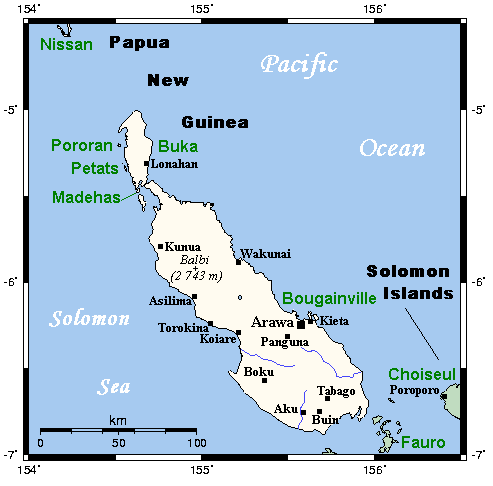 Until 1880's the territory of the Northern Solomon Islands, where, in addition to Bougainville, also includes the island of Buka, did not belong to any European colonial power and did not know the statehood. Here was the patrimony of the local Melanesian tribes. However, in 1885, Germany, which had just entered into the process of the colonial division of the world by this time, acquired its own colonies in the Asia-Pacific region. The German government turned its attention to this corner of the earth because it had not yet been fully mastered and divided by the major European powers. A colony of Germanic New Guinea was created, which included the Kaiser Wilhelm Land (northeastern part of New Guinea Island), the Bismarck Archipelago, Marshall Islands, Nauru (joined the colony in 1888 year), the Mariana Islands (became part of the colony in 1899 g .), The Caroline Islands (became part of the colony in 1899) and the North Solomon Islands. At the same time, the Mariana, Marshall and Karolinsky Islands were acquired by Germany from weakened Spain, which at that time lost the war to the United States of America and deprived of key colonies - Cuba, Puerto Rico and the Philippines.
Until 1880's the territory of the Northern Solomon Islands, where, in addition to Bougainville, also includes the island of Buka, did not belong to any European colonial power and did not know the statehood. Here was the patrimony of the local Melanesian tribes. However, in 1885, Germany, which had just entered into the process of the colonial division of the world by this time, acquired its own colonies in the Asia-Pacific region. The German government turned its attention to this corner of the earth because it had not yet been fully mastered and divided by the major European powers. A colony of Germanic New Guinea was created, which included the Kaiser Wilhelm Land (northeastern part of New Guinea Island), the Bismarck Archipelago, Marshall Islands, Nauru (joined the colony in 1888 year), the Mariana Islands (became part of the colony in 1899 g .), The Caroline Islands (became part of the colony in 1899) and the North Solomon Islands. At the same time, the Mariana, Marshall and Karolinsky Islands were acquired by Germany from weakened Spain, which at that time lost the war to the United States of America and deprived of key colonies - Cuba, Puerto Rico and the Philippines. In April, 1885, Germany declared the Northern Solomon Islands its protectorate. Initially, it included the islands of Bougainville, Buka, Choiseul, Santa Isabel and Ontong Java. Meanwhile, in 1893, the UK announced a protectorate over the southern part of the Solomon Islands, and in 1898, over the central part of the Solomon Islands. In 1899, Germany and the United Kingdom signed the Berlin Agreement, according to which Berlin refused in favor of Great Britain from the islands of Choiseul, Santa Isabel, Ontong Java and Shortland, in return receiving rejection of British claims on Samoa. Thus, there was a division of the Solomon Islands on the scope of the British administration and the German possession on the island of Bougainville.
In contrast to the southern islands transferred under the Berlin agreement under British control, the island of Bougainville and the surrounding small islands remained under German control. However, the island of Bougainville was a real backwater of the German colonial empire. The Kaiser government did not show much interest in the development of these lands. After the defeat of Germany in the First World War, its colonial possessions were divided between the countries that fought in the war against Germany. In particular, the Northern Solomon Islands were occupied by Australian troops. It was decided to transfer them under the control of Australia, including in the mandate territory of New Guinea. However, the change of colonial masters in the period under review did not strongly affect the lifestyle of the island’s population.
In 1943-1945 The territory of the island of Bougainville became the scene of bloody battles between the Japanese imperial army and the forces of allies - the United States, Australia, New Zealand and Fiji. In March - April 1942, the island was occupied by Japan, which began the construction of military bases and defensive bridgeheads. However, in November 1943, parts of the American marines landed on Cape Torokina, which entrenched on the coast and began preparations for the release of the main part of the island. The island was defended by the Japanese army 17, and the liberation of the island in November 1943 - November 1944. The following divisions were conducted: the US Marine Division 3 Division and the US 37 Division Infantry Division, the American Division, the 93 Infantry Division, and the First African American Infantry Regiment. The actions of the American units covered the Royal New Zealand Air Force. In November 1944, the operation to liberate the island was transferred to the Australian armed forces. In 1944-1945 the Fijian Infantry Regiment, units of the 3 Division and the 11 Brigade of the Australian Army fought in Bougainville. Despite the fact that the island of Bougainville itself was a small piece of land, the battles on it lasted almost two years, and around 45 thousands of Japanese soldiers and officers and 165 thousands of soldiers and officers from American, Australian, and Fijian troops. In the end, 21 August 1945. Japanese troops in Bougainville capitulated.
In 1949, the Territory of New Guinea was merged with the Territory of Papua in the Territory of Papua New Guinea. The island of Bougainville with the adjacent islands was also attributed to this administrative-territorial unit. Meanwhile, the population of the North Solomon Islands was never liked to be included in Papua New Guinea. Separatist sentiment began to grow after preparations began in the 1970 for the proclamation of independence of Papua New Guinea. The fact is that hundreds of completely different ethnic groups live in Papua New Guinea, with virtually nothing in common. For residents of the Northern Solomon Islands is characterized by a pronounced Australoid type, with very dark skin. Differences in skin color make it possible for Bougainville melanesians to call the Papuans from the island of New Guinea “redskins,” since the skin of the latter is much lighter and has brown shades.
They say the inhabitants of the Northern Solomon Islands in local languages (by the way, used for one of them - the Rotokas language - the alphabet is the shortest in the world and includes only 12 letters). These languages are poorly understood. Researchers attribute the population of Bougainville to two language families. The Severnobugvenvilskaya family brings together around 12 thousands of speakers and includes the languages Konoy (Rapoisi), Keriak (Ramopa), Eivo (Askopan) and Rotokas, which are spoken in the northern part of Bougainville Island. The Southern Uganda family brings together around 66 thousands of speakers and includes the Nasioi, Oyune, Simeku, Lantanai, Coromir, Nahovisi, Motun, Uisai and Buin languages spoken by residents of the southern part of Bougainville Island. North-uglyville and southern-uglyvilsky language families are researchers to the East-Puazian languages. However, the relationship between all the Papuan languages is not proven, therefore, in science there is a widespread point of view about the areal, not the genetic principle, of their association into language families.
In confessional terms, the majority of the population of Bougainville (about 70%) belongs to the Roman Catholic Church, although, of course, a certain influence of local traditional beliefs remains on the island. Catholic missionaries from Germany and France began their activities on Bougainville in 1902, landing on the east coast of the island. In addition to Catholics, adherents of the United Church of Papua New Guinea - a regional Protestant denomination - live on the island.
Copper and independence
History The development of copper on the island of Bougainville began with the fact that in 1963, the Australian government granted a license to develop copper mines in Panguna on the territory of the island of Bougainville to KRA Exploration. In 1969, the Australian company Conzinc Rio Tinto began exploiting the island’s natural resources. Soon copper exports began to account for 45% of Papua New Guinea's national export earnings. However, from the very first days of the start of exploitation of the island’s natural resources, serious problems arose with the purchase of land from local peasants and planters, among whom were “white” landowners who did not want to part with their lands. Moreover, the compensation that the Australian authorities offered to local landowners for the land they were taking away from them under the copper mines could hardly be called sufficient.
A consequence of the start of the development of copper mines was the arrival in Bougainville of a large number of visiting workers, first of all - people from the island of New Guinea, here referred to as "redskins". In addition to them, Australian engineers and technicians also arrived at Bougainville. Thus, the exploitation of the island’s natural resources and the labor migration of alien populations to Bougainville have become major irritating factors for local residents. The latter, firstly, were strengthened in the opinion that transnational corporations are stealing their natural resources, whereas the boogie-Willowers themselves receive practically no dividends from the exploitation of copper mines. Bougainvillea also saw that the development of mines impeded the normal economic life of the island, because as a result of exploration and mining, the flora and fauna were destroyed and, thus, the foundations of the traditional way of life of the rural population, the majority among the islanders, were undermined. Agriculture and forestry, which for centuries formed the basis of Bougainvillea life, were seriously undermined by the conduct of mining operations.
Secondly, the bougainvilleans were very annoyed by the stay on the island of large groups of foreign ethnic population, especially those from New Guinea, who are very culturally different from the inhabitants of the Northern Solomon Islands. Residents of Bougainville, who had previously been subjected to greater Christianization, considered themselves more cultural and peaceful people than visitors from New Guinea (especially if we take into account the well-known specifics of a significant part of the “shift workers” contingent who come to such earnings). Moreover, a large contingent of workers, who are young men in their prime, almost always means such negative phenomena for the local population as competition for women and an increase in street crime, including on the basis of alcohol abuse. In addition, visiting workers created by self-construction settlements on land belonging to local residents, and did not want to leave them. There were frequent instances of clashes on domestic soil between visiting workers and bougainville peasants. As a result, interethnic conflicts began in Bougainville, which provoked the development of a powerful nationalist movement that came out with separatist slogans
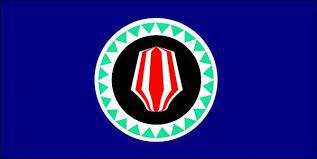
1 September 1975 of the North Solomon Islands declared independence from the Australian Territory of Papua New Guinea. By the way, two weeks after the independence of the North Solomon Islands was proclaimed, 16 September 1975 was proclaimed independence of Papua New Guinea. After six months, the Bougainville leaders agreed to join Papua New Guinea as a Bougainville Autonomous Region. Moreover, the authorities of Papua New Guinea promised the speedy establishment of genuine island autonomy with the prospect of gaining control over the financial resources obtained from the development of copper mines.
However, subsequent years showed that none of the wishes of the indigenous people of the Northern Solomon Islands was fulfilled. In particular, almost all the funds from the exploitation of copper resources went to transnational corporations and the authorities of Papua New Guinea, the development of copper mines continued on the island, and the import of foreign migrants was not stopped. The consequence of this policy was the re-uprising in Bougainville in 1988. Local residents were well aware that the development of copper mines provided there was no autonomous control of the island didn’t do anything good for them except for environmental pollution and the presence of a large number of foreign ethnic migrants. The redistribution of financial resources in favor of the island can only be achieved if the political management system of Bougainville is changed in the direction of its autonomization or even the proclamation of Bougainville’s political sovereignty.
The leading force of the separatists was the Bougainville Revolutionary Army (BRA), which, in 1990, managed to knock out the police and armed forces of Papua New Guinea from the territory of the island and unilaterally proclaim the independence of Bougainville. The island’s sovereignty was recognized by the neighboring Solomon Islands, inhabited by ethnically related tribes. By the way, it was in the capital of the Solomon Islands, Honiara that the government of Bougainville and the command of the Bougainville Revolutionary Army were located. The supreme leadership of the Bougainville Revolutionary Army was exercised by Francis She (1953-2005).
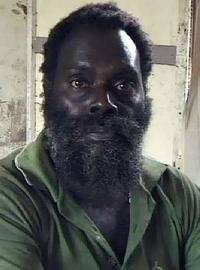 For a while, young Francis She worked at a copper mine, but then, along with her cousin Peputou Seryoure, on behalf of the Landowners Association of Panguna, spoke with the following requirements: 1) compensation by the mining company for damage in the amount of 10 million kin; 2) payment of 50% of the company's revenues to landowners and the government of Bougainville; 3) the return of all funds received from the mining company’s activities in the period from 1972 to 1988 by the Government of Papua New Guinea; 4) the gradual transfer of the copper mining company into the ownership of the provincial government of Bougainville and the landowners of the island.
For a while, young Francis She worked at a copper mine, but then, along with her cousin Peputou Seryoure, on behalf of the Landowners Association of Panguna, spoke with the following requirements: 1) compensation by the mining company for damage in the amount of 10 million kin; 2) payment of 50% of the company's revenues to landowners and the government of Bougainville; 3) the return of all funds received from the mining company’s activities in the period from 1972 to 1988 by the Government of Papua New Guinea; 4) the gradual transfer of the copper mining company into the ownership of the provincial government of Bougainville and the landowners of the island. The government of Papua New Guinea responded by preparing “compromise measures”. They included the sale of the province of Bougainville and landowners of 4,5% common stock, which were previously held by the central government; increasing compensation for pollution to the provincial government; expansion of social infrastructure on the island of Bougainville. However, these events seemed to leaders of the Pangun Landowners Association as minimal concessions from the central government. Naturally, the Bougainville activists refused to compromise with the central government and reaffirmed their intention to pursue earlier demands by any means, including by means of armed struggle for the full political independence of the island. The leaders of the Bougainvillean separatists accused the central government of Papua New Guinea and the management of the mining company of continuing the colonialist policy towards the island and its population, the merciless exploitation of natural resources and the robbery of the indigenous people of Bougainville.
The rebel detachments, which constituted the Bougainville Revolutionary Army, began sabotaging acts at the copper mines. At first, the army carried out economic sabotage against the copper mines, and also attacked employees of the mining company. In May, 1989 d. She rejected a proposal by the leadership of Papua New Guinea to conclude a compromise, after which a long and bloody civil war began on Bougainville. It was burdened by the fact that the armed groups of the bougainville rebels fought not only against the regular troops and police of Papua New Guinea, but also against each other. This was facilitated by political and inter-ethnic contradictions between the various tribes inhabiting the island of Bougainville. The war was accompanied by an increase in crime on the island, including the commission of numerous serious criminal offenses against the civilian population - murder, robbery, rape in Bougainville villages.
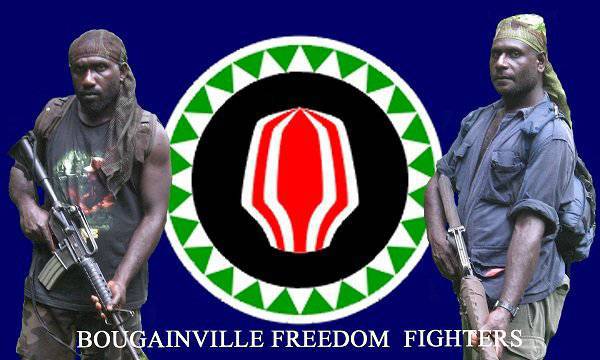
The government of Papua New Guinea decided to start an economic blockade of the island, while police and then army units were sent to Bougainville. The island was declared a state of emergency and placed under the authority of the authorized police of Papua New Guinea. In response to the island’s blockade imposed by the PNG government, 17 was proclaimed independence on May 1990 and a provisional Bougainville government was formed consisting of Francis Ona, Joseph Kabui and Sam Kaoun. Meanwhile, the government forces of Papua New Guinea were withdrawn from the island, as the Papuan leaders sought to ensure a ceasefire by the rebels. When Payas Wingti became Prime Minister of Papua New Guinea, the leadership of Papua New Guinea resumed attempts to put pressure on the Bougainville insurgency. In 1996, the successor to Wingty as prime minister of the central government, Julius Chan ordered the armed forces of Papua New Guinea to launch an invasion of Bougainville Island in order to suppress the insurgent movement.
Civil war and the proclamation of autonomy
Almost the entire two thousand army of Papua New Guinea landed on Bougainville, officially called the Papua New Guinean Defense Forces. In addition, the country's prime minister, Julius Chan, recruited international mercenaries from the private military company Sandline International to suppress the insurgency. This London-based private military company created by former lieutenant colonel of the Scottish Guard and member of the Falklands campaign, "Operation Desert Storm" and the war in Yugoslavia, Tim Spicer, staffed its ranks, especially former members of special units of the British and South African army, who had combat experience in conflicts in the territory of Angola and Sierra Leone. The company signed a contract for 36 million dollars with the government of Papua New Guinea, and its functions were officially listed as guarding the largest copper mine in Pangun, and in fact the mercenaries were supposed to support the operation of the government forces of Papua New Guinea from the air. Militants of the private military company arrived in the capital of Papua New Guinea, the city of Port Moresby and began to prepare to be sent to the territory of Bougainville.
However, details of the operation were disclosed by the Australian press. Australia demanded that the militant of a private military company immediately withdraw 44. At the same time, there was a military rebellion of officers and soldiers of the army of Papua New Guinea in the capital, Port Moresby. In the end, Tim Spicer was arrested by Papuan police. True, he was soon released and a former British lieutenant colonel hurriedly retired from Oceania. But, surprisingly, with the help of lawyers, the owner of a private military company managed to get all the 36 million dollars from the Papuan government in the contract to provide special security services to the Papua New Guinea government.
At the same time, Australia and New Zealand, to which the Government of Papua New Guinea appealed for support, including military, refused to participate in the intervention on the island. The use of the armed forces of Papua New Guinea entailed numerous violations of the rights of the civilian population of the island of Bougainville. The victims of the many years of civil war, according to various estimates, were from 10 000 to 20 000 inhabitants of the island. And this despite the fact that its population in 1990, there were hardly more than 150 thousands of inhabitants. Most of the victims were victims of the economic blockade that caused famine on the island, as well as epidemics of diseases associated with the destruction of the island’s extremely weak medical infrastructure. Moreover, as a result of the blockade of the island, medications were not delivered to its territory, as a result of which a large number of people died from tropical diseases without receiving the necessary medical care.
In addition, units of the Papua New Guinea Defense Forces, according to United Nations rapporteurs, committed war crimes against the Bougainvillean population. In particular, before the death of the BRA militants who were captured, as well as civilians suspected of participating in the separatist movement, were brutally tortured, including being tied to trucks, and the bodies were dropped from helicopters into the sea or burned in car tires. There are several cases of extrajudicial killings of leaders of the Bougainville national liberation movement. There were special centers in which government forces deployed “suspicious persons”, where they were subjected, including torture, by police and military personnel.
According to the UN, during the operations of the Papua New Guinea Defense Forces on the territory of Bougainville, citizens' rights to education, medical care, justice, and freedom of movement were systematically violated. After all, schools and hospitals practically did not function on the island, residents were deprived of the possibility of free movement due to the introduced state of emergency and prohibitions by government troops and the police. However, it is difficult to deny the facts of cruelty on the part of the Bougainville rebels. Only the workers and employees of the mining company, as a rule, became the victims of the Bougainville Revolutionary Army and smaller insurgent units, and later any immigrants from the territory of the “metropolis”, New Guinea Islands, who were accused of seizing and colonizing the island and criminal behavior to the locals.
On the other hand, the economy of Papua New Guinea suffered greatly from the costs caused by the bloody war in Bougainville. First, the war itself required serious expenditures of money, and secondly, it made it impossible to extract copper resources and, accordingly, replenish the country's budget (revenues from copper mining made up 45% of Papua New Guinea's export earnings and 20 % of the total income of the country). Accordingly, there was growing discontent with the actions of the central government and in the territory of Papua New Guinea itself, since the quality of life of the country's population deteriorated markedly in the process of fighting in Bougainville.
The government of Papua New Guinea, trying to regain control of the island, began negotiations with some Bougainvillean politicians. It should be noted here that the leadership of the Bougainville Revolutionary Army has never been united, and in fact this armed unit was a conglomerate of isolated rebel groups subordinate only to its own leaders from among the tribal leaders or “authoritative warriors”. In 1997, a cease-fire agreement was concluded with one of the rebel leaders, Joseph Kabui, who was considered a relatively moderate politician compared to Francis Ona (Joseph Kabui headed the government of Bougainville province before the outbreak of the civil war).
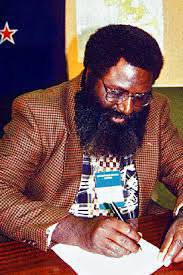
Joseph Canizius Kabui (1954-2008) headed one of the divisions of the Bougainville Revolutionary Army, but then moved on to the rhetoric of peace negotiations. This allowed him to lead the Bougainville National Congress in 2005 and be elected president of the Bougainville Autonomous Region in June, receiving the overwhelming majority of votes. His dream Kabui called the transformation of Bougainville in the "Kuwait of the Pacific Ocean". However, 2005 June 7 Kabui suddenly died of a heart attack. His active role in Bougainville’s partial pacification has been recognized by many world politicians, including UN chief Ban Ki-moon and Australian Foreign Minister Stephen Smith. Thus, back in 2008, the government of Papua New Guinea was able to achieve an agreement to include Bougainville in APG as an autonomous region, which nevertheless has its own Constitution and broad powers in the management of the island’s social, economic and cultural life. . In fact, for Papua New Guinea, there were only questions of foreign policy representation and defense.
However, this decision was not recognized by all the current figures of Bougainville policy. So, Francis She and her subordinated armed detachments of the Bougainville Revolutionary Army continued to control more than half of the island’s territory. 17 May 2004 Frances She declared herself king of Mekamouy (local name for Bougainville). He was crowned under the name of Francis Dominic Heartrance Domana, as head of the Kingdom of the Holy Land (“Holy Land” is the traditional name of the island of Bougainville, recognized by many tribes). When elections to the Autonomous Government of Bougainville took place in May 2005, Francis She did not recognize his results, saying that only 3% of Bougainvilleans participated in them, while 97% of the island’s population supported his royal government. However, 24 July 2005, Francis She died as a result of malaria in his ancestral village. Thus, the most radical supporter of the complete political independence of the island of Bougainville left the political scene, which also contributed to the further development of the negotiation process between the central government and the Bougainville activists.
Today, Bougainville is an autonomous territory governed by its own president. 10 June 2010 was elected the president of the Autonomous Region of Bougainville, John Momis, a former Catholic priest, who began to actively engage in politics in the 1970s, and in 1999-2005. Ambassador of Papua New Guinea to the People’s Republic of China. John Momis is considered a moderate politician. It is noteworthy that after the creation of autonomy, the Reserve Bank of Bougainville was headed by Alex Tsvetkoff, who lives on the island, a descendant of the Russian imperial army officer who once emigrated in the post-revolutionary years to the Solomon Islands.
The cessation of large-scale armed conflict on the island has caused the gradual return of transnational companies. So, in the spring of 2014, it became known that Bougainville Copper, which stopped working on the island of 25 years ago - in 1989, is about to return to the exploitation of the island’s natural resources. In particular, it resumes copper mining at the giant mine of Pangun. The company is jointly owned by the Australian-British group Rio Tinto, which owns 53,6% of the shares, the government of Papua New Guinea (19,1% of the shares) and a number of individuals. In addition to the development of copper mines, Bougainville Island exports copra, coconut and vanilla. However, the living conditions of the islanders are still far from being called prosperous. Therefore, it is by no means possible that in the future separatist groups may resume armed hostilities, advocating the full independence of the island from Papua New Guinea and the redistribution of income from the extraction and export of natural resources of Bougainville.
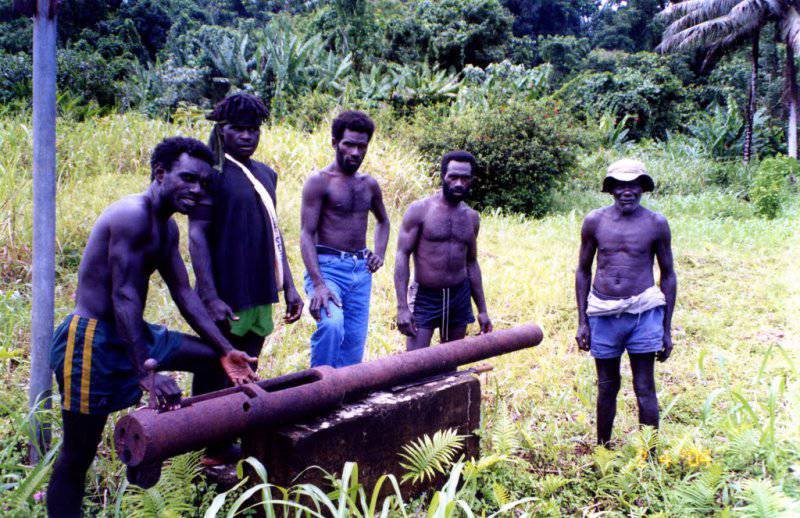
Information